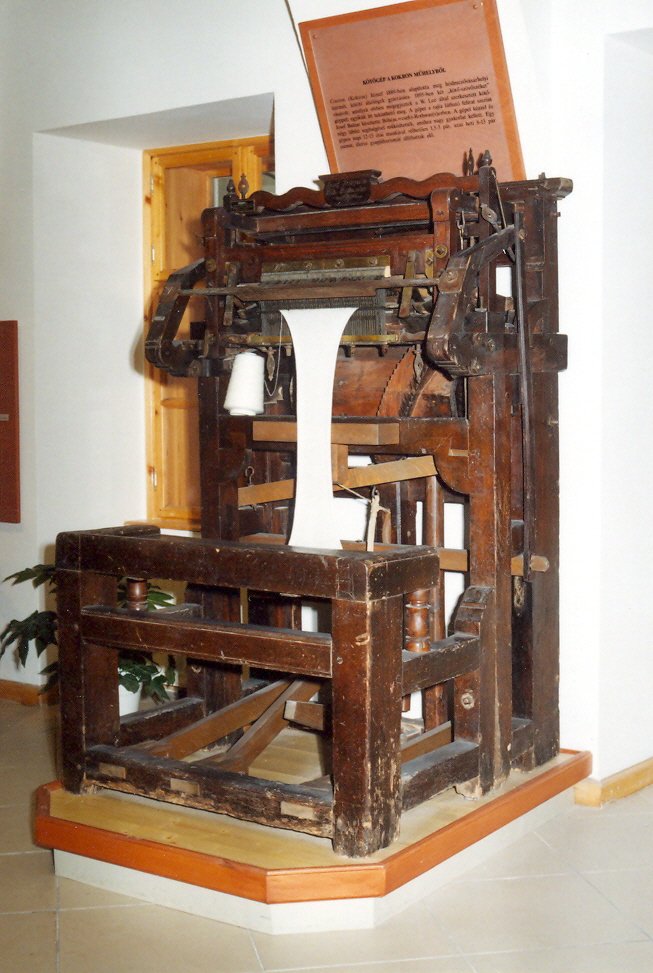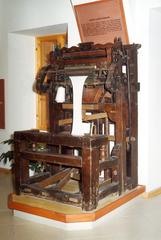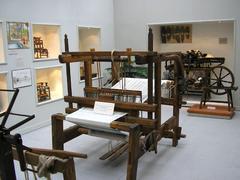
Textilmúzeum Budapest: Visiting Hours, Tickets, and Guide to the Goldberger Textile Industry Collection
Date: 14/06/2025
Introduction
Nestled in Óbuda, one of Budapest’s oldest quarters, the Goldberger Textile Industry Collection—also known as the Textilmúzeum—serves as a vibrant monument to Hungary’s textile heritage. The museum traces its origins back to 1784, when Ferenc Goldberger established a blue-dyeing workshop that would grow into one of Central Europe’s most influential textile factories. Today, the museum not only preserves this legacy through original factory buildings, machinery, and textiles, but also offers interactive workshops, contemporary art exhibitions, and inclusive visitor services. Whether you are a history enthusiast, art lover, or simply curious about Budapest’s unique cultural offerings, this guide provides all the essential information on visiting hours, ticket prices, exhibits, and travel tips to make the most of your visit.
(We Love Budapest, Goldberger Museum, Textilmúzeum Official Site)
Table of Contents
- Introduction
- Historical Background and Origins
- Cultural and Artistic Significance
- Visitor Information
- Main Exhibitions and Highlights
- Visitor Experience
- Getting There
- Nearby Attractions & Travel Tips
- Frequently Asked Questions
- Conclusion
- Sources & Further Reading
Historical Background and Origins
The Goldberger Textile Industry Collection is rooted in the Goldberger family’s blue-dyeing workshop, founded in 1784 in Óbuda. Over generations, the Goldberger factory grew into a technological and social cornerstone of Hungarian industry, renowned for both traditional crafts and pioneering industrial textile manufacturing. Surviving wars, industrial shifts, and the eventual closure in 1997, the factory’s history is now preserved within two authentic 18th-century buildings. The museum’s collections include original textile machinery, detailed archival materials, and rare examples of Hungarian folk textiles such as Matyó and Kalocsai embroidery—elements recognized as intangible cultural heritage (Springer Link).
Cultural and Artistic Significance
The Textilmúzeum is more than a historical archive; it is a living center for textile artistry. Its exhibits illuminate the evolution of folk embroidery, weaving, and dyeing techniques, with special emphasis on the role textiles played in shaping Hungarian identity and social life. The museum collaborates with artisans and artists, offering workshops, lectures, and special exhibitions that continue to inspire new generations. Temporary exhibitions frequently showcase the fusion of tradition and innovation in contemporary textile art, reinforcing the enduring relevance of these crafts.
Visitor Information
Visiting Hours
- Tuesday – Sunday: 10:00 AM – 6:00 PM
- Closed: Mondays and select public holidays (e.g., Christmas Day, New Year’s Day)
Always confirm current hours before visiting via the official website.
Ticket Prices & Discounts
- Adults: 1,400–3,000 HUF (varies by exhibition and ticket type)
- Students/Seniors (with valid ID): 700–2,000 HUF
- Children under 6: Free
- Family & Group Discounts: Available
- Budapest Card: Holders receive free or discounted entry (Budapest Card info)
Free entry is offered on the first Sunday of each month and on certain national holidays (March 15, August 20, October 23). Always verify on the official website.
Tickets: Purchase at the museum entrance or online for convenience.
Accessibility
The museum is fully wheelchair accessible, with ramps, elevators, and accessible restrooms. Exhibition information and signage are available in Hungarian and English.
Guided Tours & Workshops
- Guided Tours: Offered in Hungarian and English (60–90 minutes); advance booking recommended
- Workshops: Regular interactive sessions for all ages, including blue-dyeing and embroidery demonstrations
- School and family programs: Designed to engage children and young adults
Main Exhibitions and Highlights
- Traditional Blue-Dyeing & Textile Printing: Hands-on displays and original tools showing the evolution from artisanal craft to industrial production
- Textile Machinery & Technology: Restored looms, sewing machines, and even functioning scale models from the 19th and 20th centuries
- Hungarian Folk Textiles: Regional costumes, intricate Matyó and Kalocsai embroidery, and woven sashes that reflect Hungary’s diverse cultural history
- Goldberger Family Legacy: Personal letters, photographs, and artifacts detailing the family’s impact on Óbuda’s social and economic development
- Industrialization & Social Change: Oral histories and archival photos documenting worker life and the effects of modernization
- Contemporary Textile Art: Rotating exhibitions by Hungarian and international artists
Visitor Experience
Facilities and Amenities
- Cloakroom: Secure for coats and bags; large luggage not permitted in exhibit areas
- Restrooms: Accessible facilities on every floor
- Museum Shop: Textile-themed gifts, books, and local crafts
- Café: Light snacks and refreshments (or nearby cafés within walking distance)
- Free Wi-Fi: Available throughout the museum
Photographic Spots
Visitors are welcome to take photos (non-flash) in most areas. The museum’s restored factory halls, blue-dyeing stations, and folk textile displays provide excellent opportunities for memorable shots. For commercial or tripod photography, request permission in advance.
Getting There
Address: Lajos utca 136-138, Budapest 1036
- Tram: Lines 1 or 1A (short walk to the museum)
- Bus: Lines 34 and 106
- Metro: Line 3 (Árpád híd station), then transfer to tram
- By Car: Limited street parking; public transport is recommended due to city traffic
The museum’s central Óbuda location makes it an ideal starting point for exploring other cultural landmarks.
Nearby Attractions & Travel Tips
- Aquincum Museum & Roman Ruins: Explore Budapest’s ancient Roman past
- Óbuda Island: Green spaces, festivals, and recreation
- Vasarely Museum: Dedicated to the celebrated Hungarian-French artist
- Main Square of Óbuda: Charming historical ambiance and local cafés
Tip: Consider combined tickets for multiple Óbuda museums to save on admission.
Frequently Asked Questions (FAQ)
Q: What are the current visiting hours?
A: Tuesday–Sunday, 10:00 AM–6:00 PM (closed Mondays; check for holiday exceptions).
Q: How can I buy tickets?
A: At the museum entrance or online via the official website.
Q: Is the museum accessible for wheelchair users?
A: Yes, with ramps, elevators, and accessible restrooms.
Q: Are guided tours and workshops available?
A: Yes, in multiple languages; advance booking is recommended.
Q: Can I take photos inside?
A: Photography is allowed (without flash or tripods); commercial shoots require permission.
Q: Are there free entry days?
A: Yes, on select national holidays and the first Sunday of each month.
Conclusion
The Textilmúzeum—home to the Goldberger Textile Industry Collection—offers a unique and immersive journey through Hungary’s textile history, from folk embroidery and artisanal blue-dyeing to industrial innovation and contemporary art. With inclusive facilities, interactive workshops, and accessible visitor information, it stands out as a must-visit cultural landmark in Budapest. For an optimal experience, consult the official website for current exhibitions, free entry days, and guided tour availability, and enhance your visit with the Audiala app for audio guides and exclusive content.
Sources and Further Reading
- We Love Budapest
- Goldberger Museum
- Textilmúzeum Official Site
- Hungarian Folk Textiles as Intangible Cultural Heritage
- Museum.hu – Museum of Textile and Clothing Industry
- Budapest Card info









































































































































































